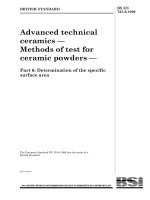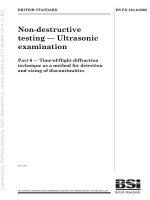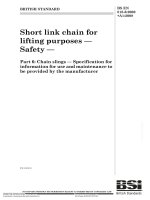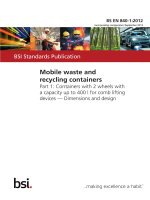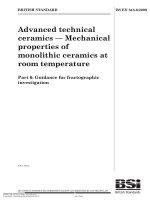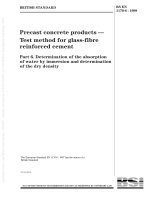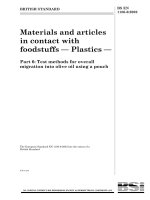Bsi bs en 61158 6 13 2014
Bạn đang xem bản rút gọn của tài liệu. Xem và tải ngay bản đầy đủ của tài liệu tại đây (1.45 MB, 70 trang )
BS EN 61158-6-13:2014
BSI Standards Publication
Industrial communication
networks — Fieldbus
specifications
Part 6-13: Application layer protocol
specification — Type 13 elements
BRITISH STANDARD
BS EN 61158-6-13:2014
National foreword
This British Standard is the UK implementation of EN 61158-6-13:2014. It is
identical to IEC 61158-6-13:2014. It supersedes BS EN 61158-6-13:2008
which is withdrawn.
The UK participation in its preparation was entrusted to Technical Committee AMT/7, Industrial communications: process measurement and
control, including fieldbus.
A list of organizations represented on this committee can be obtained on
request to its secretary.
This publication does not purport to include all the necessary provisions of
a contract. Users are responsible for its correct application.
© The British Standards Institution 2014.
Published by BSI Standards Limited 2014
ISBN 978 0 580 79476 6
ICS 25.040.40; 35.100.70; 35.110
Compliance with a British Standard cannot confer immunity from
legal obligations.
This British Standard was published under the authority of the
Standards Policy and Strategy Committee on 30 November 2014.
Amendments issued since publication
Date
Text affected
BS EN 61158-6-13:2014
EUROPEAN STANDARD
EN 61158-6-13
NORME EUROPÉENNE
EUROPÄISCHE NORM
October 2014
ICS 25.040.40; 35.100.70; 35.110
Supersedes EN 61158-6-13:2008
English Version
Industrial communication networks - Fieldbus specifications Part 6-13: Application layer protocol specification - Type 13
elements
(IEC 61158-6-13:2014)
Réseaux de communication industriels - Spécifications des
bus de terrain - Partie 6-13: Spécification du protocole de la
couche application - Eléments de type 13
(CEI 61158-6-13:2014)
Industrielle Kommunikationsnetze - Feldbusse - Teil 6-13:
Protokollspezifikation des Application Layer
(Anwendungsschicht) - Typ 13-Elemente
(IEC 61158-6-13:2014)
This European Standard was approved by CENELEC on 2014-09-23. CENELEC members are bound to comply with the CEN/CENELEC
Internal Regulations which stipulate the conditions for giving this European Standard the status of a national standard without any alteration.
Up-to-date lists and bibliographical references concerning such national standards may be obtained on application to the CEN-CENELEC
Management Centre or to any CENELEC member.
This European Standard exists in three official versions (English, French, German). A version in any other language made by translation
under the responsibility of a CENELEC member into its own language and notified to the CEN-CENELEC Management Centre has the
same status as the official versions.
CENELEC members are the national electrotechnical committees of Austria, Belgium, Bulgaria, Croatia, Cyprus, the Czech Republic,
Denmark, Estonia, Finland, Former Yugoslav Republic of Macedonia, France, Germany, Greece, Hungary, Iceland, Ireland, Italy, Latvia,
Lithuania, Luxembourg, Malta, the Netherlands, Norway, Poland, Portugal, Romania, Slovakia, Slovenia, Spain, Sweden, Switzerland,
Turkey and the United Kingdom.
European Committee for Electrotechnical Standardization
Comité Européen de Normalisation Electrotechnique
Europäisches Komitee für Elektrotechnische Normung
CEN-CENELEC Management Centre: Avenue Marnix 17, B-1000 Brussels
© 2014 CENELEC All rights of exploitation in any form and by any means reserved worldwide for CENELEC Members.
Ref. No. EN 61158-6-13:2014 E
BS EN 61158-6-13:2014
EN 61158-6-13:2014
-2-
Foreword
The text of document 65C/764/FDIS, future edition 2 of IEC 61158-6-13, prepared by SC 65C
"Industrial networks" of IEC/TC 65 "Industrial-process measurement, control and automation" was
submitted to the IEC-CENELEC parallel vote and approved by CENELEC as EN 61158-6-13:2014.
The following dates are fixed:
•
latest date by which the document has to be implemented at
national level by publication of an identical national
standard or by endorsement
(dop)
2015-06-23
•
latest date by which the national standards conflicting with
the document have to be withdrawn
(dow)
2017-09-23
This document supersedes EN 61158-6-13:2008.
Attention is drawn to the possibility that some of the elements of this document may be the subject of
patent rights. CENELEC [and/or CEN] shall not be held responsible for identifying any or all such
patent rights.
This document has been prepared under a mandate given to CENELEC by the European Commission
and the European Free Trade Association.
Endorsement notice
The text of the International Standard IEC 61158-6-13:2014 was approved by CENELEC as a
European Standard without any modification.
In the official version, for Bibliography, the following notes have to be added for the standards indicated:
IEC 61158-1
NOTE
Harmonized as EN 61158-1.
IEC 61158-6
NOTE
Harmonized as EN 61158-6 series.
IEC 61784-1
NOTE
Harmonized as EN 61784-1.
IEC 61784-2
NOTE
Harmonized as EN 61784-2.
BS EN 61158-6-13:2014
EN 61158-6-13:2014
-3-
Annex ZA
(normative)
Normative references to international publications
with their corresponding European publications
The following documents, in whole or in part, are normatively referenced in this document and are
indispensable for its application. For dated references, only the edition cited applies. For undated
references, the latest edition of the referenced document (including any amendments) applies.
NOTE 1
When an International Publication has been modified by common modifications, indicated by (mod),
the relevant EN/HD applies.
NOTE 2
Up-to-date information on the latest versions of the European Standards listed in this annex is
available here: www.cenelec.eu.
Publication
Year
Title
EN/HD
Year
IEC 61158-3-13
-
Industrial communication networks Fieldbus specifications Part 3-13: Data link layer service
definition - Type 13 elements
EN 61158-3-13
-
IEC 61158-4-13
-
Industrial communication networks Fieldbus specifications Part 4-13: Data-link layer protocol
specification - Type 13 elements
EN 61158-4-13
-
IEC 61158-5-13
-
Industrial communication networks Fieldbus specifications Part 5-13: Application layer service
definition - Type 13 elements
EN 61158-5-13
-
ISO/IEC 7498
series
Information technology - Open Systems
Interconnection - Basic reference model
-
-
ISO/IEC 7498-1
-
Information technology - Open Systems
Interconnection - Basic reference model:
The basic model
-
-
ISO/IEC 8802-3
-
Information technology Telecommunications and information
exchange between systems - Local and
metropolitan area networks - Specific
requirements Part 3: Carrier sense multiple access with
collision detection (CSMA/CD) access
method and physical layer specifications
-
-
ISO/IEC 8822
-
Information technology - Open Systems
Interconnection - Presentation service
definition
-
-
ISO/IEC 8824-1
-
Information technology - Abstract Syntax
Notation One (ASN.1): Specification of
basic notation
-
-
BS EN 61158-6-13:2014
EN 61158-6-13:2014
-4-
Publication
Year
Title
EN/HD
Year
ISO/IEC 9545
-
Information technology - Open Systems
Interconnection - Application layer structure
-
-
ISO/IEC 9899
-
Information technology - Programming
languages - C
-
-
IEEE 754
-
IEEE Standard for Floating-Point Arithmetic
-
-
–2–
BS EN 61158-6-13:2014
IEC 61158-6-13:2014 © IEC 2014
CONTENTS
INTRODUCTION ..................................................................................................................... 7
1
Scope ............................................................................................................................... 8
2
1.1 General ................................................................................................................... 8
1.2 Specifications .......................................................................................................... 8
1.3 Conformance ........................................................................................................... 9
Normative references ....................................................................................................... 9
3
Terms, definitions, symbols, abbreviations and conventions ............................................. 9
4
3.1
3.2
3.3
3.4
3.5
3.6
3.7
FAL
5
4.1 General ................................................................................................................. 12
4.2 FAL-AR PDU abstract syntax ................................................................................ 12
4.3 Abstract syntax of Asyn1 pduBody ........................................................................ 15
4.4 Abstract syntax of Asyn2 pduBody ........................................................................ 16
Transfer syntax .............................................................................................................. 23
6
5.1 Encoding of data types .......................................................................................... 23
FAL protocol state machines .......................................................................................... 27
7
AP context state machine ............................................................................................... 28
8
FAL service protocol machine ......................................................................................... 28
9
AR protocol machine ...................................................................................................... 29
9.1
9.2
9.3
9.4
9.5
10 DLL
ISO/IEC 7498-1 terms ........................................................................................... 10
ISO/IEC 8822 terms .............................................................................................. 10
ISO/IEC 9545 terms .............................................................................................. 10
ISO/IEC 8824-1 terms ........................................................................................... 10
Terms and definitions from IEC 61158-5-13 ........................................................... 11
Other terms and definitions ................................................................................... 11
Abbreviations and symbols .................................................................................... 11
syntax description ................................................................................................... 12
Buffered-network-scheduled bi-directional pre-established connection (BNBPEC) ARPM .......................................................................................................... 29
Buffered-network-scheduled uni-directional pre-established connection
(BNU-PEC) ARPM ................................................................................................. 31
Queued user-triggered uni-directional (QUU) ARPM .............................................. 33
Queued user-triggered bi-directional connectionless (QUB-CL) ARPM .................. 36
Queued user-triggered bi-directional connection-oriented with segmentation
(QUB-COS) ARPM ................................................................................................ 40
mapping protocol machine ...................................................................................... 58
10.1 Primitive definitions ............................................................................................... 58
10.2 DMPM state machine ............................................................................................ 59
Annex A (normative) Constant value assignments................................................................ 61
A.1 Values of abort-code ............................................................................................. 61
A.2 NMT-command-ID ................................................................................................. 62
A.3 Type 13 specific error-code constants ................................................................... 62
A.4 Node-list................................................................................................................ 64
Bibliography .......................................................................................................................... 65
Figure 1 – Encoding of Time of Day value ............................................................................. 26
BS EN 61158-6-13:2014
IEC 61158-6-13:2014 © IEC 2014
–3–
Figure 2 – Encoding of Time Difference value ....................................................................... 27
Figure 3 – Primitives exchanged between protocol machines ................................................ 28
Figure 4 – State transition diagram of BNB-PEC ARPM ........................................................ 30
Figure 5 – State transition diagram of BNU-PEC ARPM ........................................................ 32
Figure 6 – State transition diagram of QUU ARPM ................................................................ 35
Figure 7 – State transition diagram of QUB-CL ARPM .......................................................... 38
Figure 8 – State transition diagram of QUB-COS (CmdL) ARPM ........................................... 43
Figure 9 – State transition diagram of QUB-COS (SeqL) ARPM ............................................ 55
Figure 10 – State transition diagram of DMPM ...................................................................... 59
Table 1 – Use of signaling-flags ............................................................................................ 14
Table 2 – Values of error-type............................................................................................... 18
Table 3 – Transfer syntax for bit sequences .......................................................................... 23
Table 4 – Transfer syntax for data type UNSIGNEDn ............................................................ 24
Table 5 – Transfer syntax for data type INTEGERn ............................................................... 25
Table 6 – Primitives issued by user to BNB-PEC ARPM ........................................................ 29
Table 7 – Primitives issued by BNB-PEC ARPM to user ........................................................ 29
Table 8 – BNB-PEC ARPM state table – sender transactions ................................................ 30
Table 9 – BNB-PEC ARPM state table – receiver transactions .............................................. 31
Table 10 – Function BuildFAL-PDU ....................................................................................... 31
Table 11 – Primitives issued by user to BNU-PEC ARPM ...................................................... 31
Table 12 – Primitives issued by BNU-PEC ARPM to user ...................................................... 31
Table 13 – BNU-PEC ARPM state table – sender transactions .............................................. 33
Table 14 – BNU-PEC ARPM state table – receiver transactions ............................................ 33
Table 15 – Function BuildFAL-PDU ....................................................................................... 33
Table 16 – Primitives issued by user to QUU ARPM ............................................................. 33
Table 17 – Primitives issued by QUU ARPM to user ............................................................. 34
Table 18 – QUU ARPM state table – sender transactions ..................................................... 35
Table 19 – QUU ARPM state table – receiver transactions .................................................... 35
Table 20 – Function BuildFAL-PDU ....................................................................................... 36
Table 21 – Primitives issued by user to QUB-CL ARPM ........................................................ 36
Table 22 – Primitives issued by QUB-CL ARPM to user ........................................................ 37
Table 23 – QUB-CL ARPM state table – sender transactions ................................................ 39
Table 24 – QUB-CL ARPM state table – receiver transactions .............................................. 40
Table 25 – Function BuildFAL-PDU ....................................................................................... 40
Table 26 – Primitives issued by user to QUB-COS (CmdL) ARPM ......................................... 41
Table 27 – Primitives issued by QUB-COS (CmdL) ARPM to user ......................................... 42
Table 28 – QUB-COS (CmdL) ARPM state table – sender transactions ................................. 44
Table 29 – QUB-COS (CmdL) ARPM state table – receiver transactions ............................... 49
Table 30 – Function BuildSegment ....................................................................................... 51
Table 31 – Function RoundUp ............................................................................................... 51
Table 32 – Function MoreFollows ......................................................................................... 51
–4–
BS EN 61158-6-13:2014
IEC 61158-6-13:2014 © IEC 2014
Table 33 – Function AddSegment ......................................................................................... 52
Table 34 – Function GetIntermediatePDU ............................................................................. 52
Table 35 – Primitives issued by QUB-COS (CmdL) to QUB-COS (SeqL) ............................... 52
Table 36 – Primitives issued by QUB-COS (SeqL) to QUB-COS (CmdL) ............................... 53
Table 37 – Parameters used with primitives exchanged between QUB-COS (SeqL)
and QUB-COS (CmdL) .......................................................................................................... 53
Table 38 – QUB-COS (SeqL) ARPM states ........................................................................... 54
Table 39 – QUB-COS (SeqL) ARPM state table – sender transactions .................................. 55
Table 40 – QUB-COS (SeqL) ARPM state table – receiver transactions ................................ 56
Table 41 – Function BuildFAL-PDU ....................................................................................... 58
Table 42 – Function IncrementCounter ................................................................................. 58
Table 43 – Function AddToHistoryBuffer ............................................................................... 58
Table 44 – Primitives issued by ARPM to DMPM .................................................................. 58
Table 45 – Primitives issued by DMPM to ARPM .................................................................. 58
Table 46 – Primitives issued by DMPM to data-link layer ...................................................... 59
Table 47 – Primitives issued by data-link layer to DMPM ...................................................... 59
Table 48 – DMPM state table – sender transactions ............................................................. 60
Table 49 – DMPM state table – receiver transactions ............................................................ 60
Table A.1 – Values of abort-code .......................................................................................... 61
Table A.2 – Values of NMTCommandID ................................................................................ 62
Table A.3 – Type 13 specific error-code constants ................................................................ 63
Table A.4 – Node-list format ................................................................................................. 64
BS EN 61158-6-13:2014
IEC 61158-6-13:2014 © IEC 2014
–7–
INTRODUCTION
This part of IEC 61158 is one of a series produced to facilitate the interconnection of
automation system components. It is related to other standards in the set as defined by the
“three-layer” fieldbus reference model described in IEC 61158-1.
The application protocol provides the application service by making use of the services
available from the data-link or other immediately lower layer. The primary aim of this standard
is to provide a set of rules for communication expressed in terms of the procedures to be
carried out by peer application entities (AEs) at the time of communication. These rules for
communication are intended to provide a sound basis for development in order to serve a
variety of purposes:
–
as a guide for implementors and designers;
–
for use in the testing and procurement of equipment;
–
as part of an agreement for the admittance of systems into the open systems environment;
–
as a refinement to the understanding of time-critical communications within OSI.
This standard is concerned, in particular, with the communication and interworking of sensors,
effectors and other automation devices. By using this standard together with other standards
positioned within the OSI or fieldbus reference models, otherwise incompatible systems may
work together in any combination.
–8–
BS EN 61158-6-13:2014
IEC 61158-6-13:2014 © IEC 2014
INDUSTRIAL COMMUNICATION NETWORKS –
FIELDBUS SPECIFICATIONS –
Part 6-13: Application layer protocol specification –
Type 13 elements
1
1.1
Scope
General
The fieldbus application layer (FAL) provides user programs with a means to access the
fieldbus communication environment. In this respect, the FAL can be viewed as a “window
between corresponding application programs.”
This standard provides common elements for basic time-critical and non-time-critical
messaging communications between application programs in an automation environment and
material specific to Type 13 fieldbus. The term “time-critical” is used to represent the
presence of a time-window, within which one or more specified actions are required to be
completed with some defined level of certainty. Failure to complete specified actions within
the time window risks failure of the applications requesting the actions, with attendant risk to
equipment, plant and possibly human life.
This standard specifies interactions between remote applications and defines the externally
visible behavior provided by the Type 13 fieldbus application layer in terms of
a) the formal abstract syntax defining the application layer protocol data units conveyed
between communicating application entities;
b) the transfer syntax defining encoding rules that are applied to the application layer
protocol data units;
c) the application context state machine defining the application service behavior visible
between communicating application entities;
d) the application relationship state machines defining the communication behavior visible
between communicating application entities.
The purpose of this standard is to define the protocol provided to
1) define the wire-representation of the service primitives defined in IEC 61158-5-13, and
2) define the externally visible behavior associated with their transfer.
This standard specifies the protocol of the Type 13 fieldbus application layer, in conformance
with the OSI Basic Reference Model (ISO/IEC 7498) and the OSI application layer structure
(ISO/IEC 9545).
1.2
Specifications
The principal objective of this standard is to specify the syntax and behavior of the application
layer protocol that conveys the application layer services defined in IEC 61158-5-13.
A secondary objective is to provide migration paths from previously-existing industrial
communications protocols. It is this latter objective which gives rise to the diversity of
protocols standardized in IEC 61158-6.
BS EN 61158-6-13:2014
IEC 61158-6-13:2014 © IEC 2014
1.3
–9–
Conformance
This standard does not specify individual implementations or products, nor does it constrain
the implementations of application layer entities within industrial automation systems.
Conformance is achieved through implementation of this application layer protocol
specification.
2
Normative references
The following documents, in whole or in part, are normatively referenced in this document and
are indispensable for its application. For dated references, only the edition cited applies. For
undated references, the latest edition of the referenced document (including any
amendments) applies.
NOTE All parts of the IEC 61158 series, as well as IEC 61784-1 and IEC 61784-2 are maintained simultaneously.
Cross-references to these documents within the text therefore refer to the editions as dated in this list of normative
references.
IEC 61158-3-13, Industrial communication networks – Fieldbus specifications – Part 3-13:
Data-link layer service definition – Type 13 elements
IEC 61158-4-13, Industrial communication networks – Fieldbus specifications – Part 4-13:
Data-link layer protocol specification – Type 13 elements
IEC 61158-5-13, Industrial communication networks – Fieldbus specifications – Part 5-13:
Application layer service definition – Type 13 elements
ISO/IEC 7498 (all parts), Information technology – Open Systems Interconnection – Basic
Reference Model
ISO/IEC 7498-1, Information technology – Open Systems Interconnection – Basic Reference
Model: The Basic Model
ISO/IEC 8802-3, Information technology – Telecommunications and information exchange
between systems – Local and metropolitan area networks – Specific requirements – Part 3:
Carrier sense multiple access with collision detection (CSMA/CD) access method and
physical layer specifications
ISO/IEC 8822, Information technology – Open Systems Interconnection – Presentation
service definition
ISO/IEC 8824-1, Information
Specification of basic notation
technology
–
Abstract
Syntax
Notation
One
(ASN.1):
ISO/IEC 9545, Information technology – Open Systems Interconnection – Application Layer
structure
ISO/IEC 9899, Information technology – Programming languages – C
IEEE 754, IEEE Standard for Floating-Point Arithmetic
3
Terms, definitions, symbols, abbreviations and conventions
For the purposes of this document, the following terms, definitions, symbols, abbreviations
and conventions apply.
– 10 –
3.1
BS EN 61158-6-13:2014
IEC 61158-6-13:2014 © IEC 2014
ISO/IEC 7498-1 terms
This standard is partly based on the concepts developed in ISO/IEC 7498-1, and makes use
of the following terms defined therein:
3.1.1 application entity
3.1.2 application process
3.1.3 application protocol data unit
3.1.4 application service element
3.1.5 application entity invocation
3.1.6 application transaction
3.1.7 transfer syntax
3.2
ISO/IEC 8822 terms
For the purposes of this document, the following term as defined in ISO/IEC 8822 applies:
3.2.1 abstract syntax
3.3
ISO/IEC 9545 terms
For the purposes of this document, the following terms as defined in ISO/IEC 9545 apply:
3.3.1 application-context
3.3.2 application-process-type
3.3.3 application-service-element
3.3.4 application control service element
3.4
ISO/IEC 8824-1 terms
For the purposes of this document, the following terms as defined in ISO/IEC 8824-1 apply:
3.4.1 any type
3.4.2 bitstring type
3.4.3 boolean type
3.4.4 choice type
3.4.5 false
3.4.6 integer type
3.4.7 module
3.4.8 null type
3.4.9 object identifier
3.4.10 octetstring type
3.4.11 production
3.4.12 simple type
3.4.13 sequence of type
3.4.14 sequence type
3.4.15 structured type
3.4.16 tag
3.4.17 tagged type
BS EN 61158-6-13:2014
IEC 61158-6-13:2014 © IEC 2014
– 11 –
3.4.18 true
3.4.19 type
3.5
Terms and definitions from IEC 61158-5-13
3.5.1 application relationship
3.5.2 client
3.5.3 error class
3.5.4 publisher
3.5.5 server
3.5.6 subscriber
3.6
Other terms and definitions
The following terms and definitions are used in this standard:
3.6.1
receiving
service user that receives a confirmed primitive or an unconfirmed primitive, or a service
provider that receives a confirmed APDU or an unconfirmed APDU
3.6.2
resource
processing or information capability of a subsystem
3.6.3
sending
service user that sends a confirmed primitive or an unconfirmed primitive, or a service
provider that sends a confirmed APDU or an unconfirmed APDU
3.6.4
managing node
node that can manage the SCNM mechanism
3.6.5
controlled node
node without the ability to manage the SCNM mechanism
3.7
Abbreviations and symbols
AE
Application entity
AL
Application layer
AP
Application process
APDU
Application protocol data unit
AR
Application relationship
AREP
Application relationship end point
ARPM
Application relationship protocol machine
ASnd
Asynchronous Send (Type 13 frame type)
BNB-PEC
Buffered network-scheduled bi-directional pre-established connection
BNU-PEC
Buffered network-scheduled uni-directional pre-established connection
CmdL
Command layer
CN
Controlled node
– 12 –
BS EN 61158-6-13:2014
IEC 61158-6-13:2014 © IEC 2014
cnf
confirmation
DL-
(as a prefix) data-link-
DLCEP
Data-link connection end point
DLL
Data-link layer
DLME
Data-link-management entity
DLSAP
Data-link service access point
DLSDU
DL-service-data-unit
DMPM
DLL mapping protocol machine
DNS
Domain name service
FAL
Fieldbus application layer
ind
indication
IP
Internet protocol (see RFC 791)
MAC
Media access controll
MN
Managing node
NMT
Network management
OD
Object dictionary
PDO
Process data object
PDU
Process data unit
QUB-CL
Queued user-triggered bi-directional connectionless
QUB-COS
Queued
user-triggered
segmentation
QUU
Queued user-triggered uni-directional
req
request
rsp
response
SDO
Service data object
SeqL
Sequence layer
UDP
User datagram protocol
4
bi-directional
connection-oriented
with
FAL syntax description
4.1
General
This description of the Type 13 abstract syntax uses formalisms similar to ASN.1, although
the encoding rules differ from that standard.
4.2
4.2.1
FAL-AR PDU abstract syntax
Top level definition
APDU ::= CHOICE {
[3] Isoc1
[4] Isoc2
[5] Asyn1
[6] Asyn2
}
BS EN 61158-6-13:2014
IEC 61158-6-13:2014 © IEC 2014
4.2.2
– 13 –
Isoc1
Isoc1 ::= SEQUENCE {
message-type
destination
source
reserved
signaling-flags
PDO-version
reserved8
size
PDO-payload
}
4.2.3
Isoc2
Isoc2 ::= SEQUENCE {
message-type
destination
source
NMT-status
signaling-flags
PDO-version
reserved8
size
PDO-payload
}
4.2.4
Asyn1
Asyn1 ::= SEQUENCE {
message-type
destination
source
NMT-status
signaling-flags
requested-service-ID
requested-service-target
fieldbus-version
reserved8
pduBody
CHOICE{
[1h…5h] reserved
[6h] Sync-request
[7h...FFh] reserved
}
}
4.2.5
Asyn2
Asyn2 ::= SEQUENCE {
message-type
destination
source
service-ID
pduBody
CHOICE {
[1h] ident-response
[2h] status-response
[3h] NMT-request
[4h] NMT-command
[5h] SDO
[6h] Sync-response
[A0h…FEh] manufacturer-specific
[FFh] reserved
}
}
4.2.6
Message-type
message-type ::= Unsigned8
— Contains the context specific APDU tags
– 14 –
4.2.7
Addresses
destination ::= Unsigned8
source ::= Unsigned8
4.2.8
— Node address (1…255)
— Node address (1…250, 253, 254)
Service-ID
service-ID ::= Unsigned8
4.2.9
BS EN 61158-6-13:2014
IEC 61158-6-13:2014 © IEC 2014
— Contains the context specific tags for the pduBody
Reserved8
reserved8 ::= Unsigned8
4.2.10
Reserved16
reserved16 ::= Unsigned16
4.2.11
Reserved24
reserved24 ::= Unsigned24
4.2.12
Signaling-flags
signaling-flags ::= BitString {
RD
(0)
ER
(1)
EA
(2)
EC
(3)
EN
(4)
MS
(5)
PS
(6)
MC
(7)
RS_bit1
(8)
RS_bit2
(9)
RS_bit3
(10)
PR_bit1
(11)
PR_bit2
(12)
PR_bit3
(13)
reserved
(14)
reserved
(15)
}
The different APDU types use the flags as listed in Table 1. In all cases without "x" the flags
are present but not written resp. interpreted.
Table 1 – Use of signaling-flags
RD
Isoc1
Isoc2
x
x
ER
EA
Asyn1
IdentResponse
SyncResponse
x
x
x
EC
x
EN
MS
StatusResponse
x
x
x
x
RS
x
x
x
x
PR
x
x
x
x
PS
MC
The usage of these flags is specified in IEC 61158-3-13 and IEC 61158-4-13.
BS EN 61158-6-13:2014
IEC 61158-6-13:2014 © IEC 2014
4.2.13
– 15 –
PDO-version
PDO-version ::= Unsigned8
4.2.14
— High nibble: main version; low nibble: sub version
Size
size ::= Unsigned8
4.2.15
— Size of PDO payload; max. 1490 octets due to
Ethernet restrictions and protocol overhead
PDO-payload
PDO-payload ::= Any
4.2.16
NMT-status
NMT-status ::= CHOICE {
NMT_GS_OFF
NMT_xS_NOT_ACTIVE
NMT_xS_PRE_OPERATIONAL_1
NMT_xS_PRE_OPERATIONAL_2
NMT_xS_READY_TO_OPERATE
NMT_xS_OPERATIONAL
NMT_xS_STOPPED
NMT_xS_BASIC_ETHERNET
}
NOTE
Unsigned8
Unsigned8
Unsigned8
Unsigned8
Unsigned8
Unsigned8
Unsigned8
Unsigned8
Requested-service-ID
requested-service-ID ::= CHOICE {
no-service
ident-request
status-request
NMT-req-inv
manufacturer-specific
unspecified-invite
}
4.2.18
[0h] IMPLICIT Unsigned8
[1h] IMPLICIT Unsigned8
[2h] IMPLICIT Unsigned8
[3h] IMPLICIT Unsigned8
[A0h]… [FEh] IMPLICIT Unsigned8
[FFh] IMPLICIT Unsigned8
Requested-service-target
requested-service-target ::= Unsigned8
4.2.19
— Node address (1…255); not assigned (0)
Fieldbus-version
fieldbus-version ::= Unsigned8
— High nibble: main version; low nibble: sub version
Abstract syntax of Asyn1 pduBody
4.3.1
4.3.1.1
Sync-request
Overview
Sync-request ::= SEQUENCE {
synchronization-control
Bitstring
PRes-time
Unsigned32
}
0000 0000b
0001 1100b
0001 1101b
0101 1101b
0110 1101b
1111 1101b
0100 1101b
0001 1110b
If sender = MN: "x" := "M"; if sender = CN: "x" := "C".
4.2.17
4.3
::=
::=
::=
::=
::=
::=
::=
::=
reserved
sync-MN-delay
reserved
fallback-timeout
Unsigned32
Unsigned32
Unsigned32
Unsigned32
destination-MAC-address
Unsigned32
— see 4.3.1.2
— time delay between end of the reception of the PRes from MN
and start of sending the own time-triggered PRes in ns
— propagation delay between MN and CN in ns
— SoC timeout for deactivating the time-triggered sending of PRes
in state NMT_CS_PRE_OPERATIONAL_2 in ns
— destination MAC address of the node the Sync-request is sent to
NOTE The above listed elements are sometimes summarized as follows:
"synchronization-control" through "destination-MAC-address" are summarized under the term "sync-control".
– 16 –
4.3.1.2
Synchronization-control
Synchronization-control ::= Bitstring {
PRes-time-valid
(0)
Reserved bit1
(1)
sync-MN-delay-valid
(2)
reserved bit2
(3)
fallback-timeout-valid
(4)
reserved bit3
(5)
MAC-address-valid
(4)
reserved bit4 through bit26 (7)…(29)
PRes-mode-reset
(30)
PRes-mode-set
(31)
}
4.4
BS EN 61158-6-13:2014
IEC 61158-6-13:2014 © IEC 2014
— The parameter PRes-time is valid
— The parameter sync-MN-delay is valid
— The parameter fallback-timeout is valid
— The parameter destination-MAC-address is valid
— Deactivate the time-triggered sending of PRes
— Activate the time-triggered sending of PRes. This bit overules
bit30
Abstract syntax of Asyn2 pduBody
4.4.1
Ident-response
4.4.1.1
Overview
Ident-response ::= SEQUENCE
signaling-flags
NMT-status
reserved8
fieldbus-version
reserved8
feature-flags
MTU
poll-in-size
poll-out-size
response-time
reserved16
device-type
vendor-ID
product-code
revision-number
serial-number
vendor-specific-extension-1
verify-configuration-date
verify-configuration-time
application-sw-date
application-sw-time
IP-address
subnet-mask
default-gateway
host-name
vendor-specific-extension-2
}
NOTE
{
BitString
Unsigned16
Unsigned16
Unsigned16
Unsigned32
—
—
—
—
—
(see 4.4.1.2)
size of the largest possible IP frame incl. header
actual CN setting for Isoc1 data block size
actual CN setting for Isoc2 data block size
time required by the CN to respond to Isoc1
Unsigned32
— CN’s device type
Unsigned32
— CN’s vendor ID
Unsigned32
— CN’s product code
Unsigned32
— CN’s revision number
Unsigned32
— CN’s serial number
Unsigned64
— for vendor specific purpose, to be filled with zeros if not used
Unsigned32
— CN’s configuration date
Unsigned32
— CN’s configuration time
Unsigned32
— CN’s application software date
Unsigned32
— CN’s application software time
Unsigned32
— current IP address value of the CN
Unsigned32
— current IP subnet mask of the CN
Unsigned32
— current IP default gateway of the CN
VisibleString32 — current DNS host name of the CN
SEQUENCE SIZE(48) OF Unsigned8
—for vendor specific purpose, to be filled with zeros if not in use
Some of the above listed elements are sometimes summarized as follows:
"poll-in-size" through "response-time" are summarized under the term "cycle-timing",
"device-type" through "serial-number" under "identity",
"verify-configuration-date" and "verify-configuration-time" under "verify-configuration",
"application-sw-date" and "application-sw-time" under "application-software-version",
"vendor-specific-extension-1" and "vendor-specific-extension-2" under "vendor-specific-extensions",
"IP-address" through "default-gateway" under "IP-address".
BS EN 61158-6-13:2014
IEC 61158-6-13:2014 © IEC 2014
4.4.1.2
Feature-flags
feature-flags ::= BitString {
Isochronous
SDO by UDP/IP
SDO by ASnd
reserved for future use
NMT-info services
Extended NMT-state-commands
Dynamic PDO mapping
NMT services by UDP/IP
Configuration manager
Multiplexed access
Node-ID setup by SW
MN basic ethernet mode
Routing Type 1 support
Routing Type 2 support
WriteMultipleByIndex
ReadMultipleByIndex
reserved bit1 through bit2
Time-triggered PRes
reserved bit3 through bit16
}
4.4.2
4.4.2.1
– 17 –
(0)
—
(1)
—
(2)
—
(3)
(4)
—
(5)
—
(6)
—
(7)
—
(8)
—
(9)
—
(10)
—
(11)
—
(12)
—
(13)
—
(14)
—
(15)
—
(16)…(17)
(18)
—
(19)…(31)
device may be isochronously accessed via Isoc1
device supports SDO communication via UDP/IP
device supports SDO communication via ASnd
device supports NMT Info Services
device supports Extended NMT State Commands
device supports dynamic PDO Mapping
device supports NMT Services by UDP/IP
device supports Configuration Manager functions
CN device supports multiplexed isochronous access.
device supports NodeID setup by software
MN device supports Basic Ethernet Mode
device supports Routing Type 1 functions
device supports Routing Type 2 functions
device supports WriteMultipleByIndex SDO service
device supports ReadMultipleByIndex SDO service
device supports time-triggered sending of PRes
Status-response
Overview
Status-response ::= SEQUENCE {
signaling-flags
NMT-status
reserved24
static-error-bit-field
List-of-errors
}
4.4.2.2
Static-error-bitfield
static-error-bit-field ::= SEQUENCE {
error-register
BitString
reserved8
specific-errors
SEQUENCE SIZE (6) OF Unsigned8
}
4.4.2.3
(0)
(1)
(2)
(3)
(4)
(5)
(6)
(7)
OPTIONAL
OPTIONAL
OPTIONAL
OPTIONAL
OPTIONAL
OPTIONAL
OPTIONAL
— 0, if no static error present, else 1
— always 0
List-of-errors
List-of-errors ::= SEQUENCE SIZE (k) OF ErrorEntry
4.4.2.5
— Device profile or vendor specific errors
Error-register
error-register ::= BitString {
Generic error
Current
Voltage
Temperature
Communication error
Device profile specific
reserved
Manufacturer specific
}
4.4.2.4
— (see 4.4.2.3)
— k :>= 2, depends on device configuration
ErrorEntry
ErrorEntry ::= SEQUENCE {
error-type
error-code
time-stamp
additional-information
}
Unsigned16
Unsigned16
Unsigned64
Unsigned64
— (see 4.4.2.6)
— (see 4.4.2.6 and Clause A.3)
– 18 –
4.4.2.6
BS EN 61158-6-13:2014
IEC 61158-6-13:2014 © IEC 2014
Error-type
The possible values in error-type and their meaning are listed in Table 2.
Table 2 – Values of error-type
Octet
0 .. 1
Bit
15
(status)
14
(send)
13 .. 12
(mode)
11 .. 0
(profile)
4.4.3
Value
Description
0b
Error-history entry
1b
Status entry in Status-response frame (Bit 14 shall be set to 0b)
0b
Error-history entry only
1b
Additional to the error-history entry the entry shall also be entered in to the
emergency queue of the error signaling
0h
Not allowed in error-history entry. Entries with this mode may only be used by the
error signaling itself to indicate the termination of the history entries in the Statusresponse frame
1h
An error has occurred and is active (e.g. short circuit of output detected)
2h
An active error was cleared (e.g. no short circuit anymore) (not allowed for status
entries)
3h
An error / event occurred (not allowed for status entries)
000h
Reserved
001h
error-code contains a vendor specific error code
002h
error-code contains Type 13 network specific communication profile errors
(see Clause A.3)
003h ..
FFFh
error-code contains device profile specific errors
NMT-request
NMT-request ::= SEQUENCE {
NMT-requested-command-ID
NMT-requested-command-target
NMT-requested-command-data
}
4.4.4
node-states
NULL
4.4.5
4.4.5.1
SDO
Overview
SDO ::= SEQUENCE {
SequenceLayer
CommandLayer
}
Unsigned8
Unsigned8
SEQUENCE SIZE (255) OF Unsigned8
node-list
}
— value range see Clause A.2
— target node address
NMT-command
NMT-command ::= SEQUENCE {
NMT-command-ID CHOICE {
NMT-state-command
NMT-info
}
reserved8
NMT-command-data CHOICE {
date-time
TimeOfDay
}
Unsigned8
Unsigned8
Any
— value range see Clause A.2
— only if NMT-command-ID = B0h;
see Clause A.4
— if NMT-command-ID = 96h;
see Clause A.4;
reports each node state individually
— if NMT-command-ID = 40h...95h, A0h;
see Clause A.4
— else
BS EN 61158-6-13:2014
IEC 61158-6-13:2014 © IEC 2014
4.4.5.2
SequenceLayer
SequenceLayer ::= SEQUENCE {
SequenceFlags
Bitstring {
rcon_bit1
rcon_bit2
rsnr_bit1
rsnr_bit2
rsnr_bit3
rsnr_bit4
rsnr_bit5
rsnr_bit6
scon_bit1
scon_bit2
ssnr_bit1
ssnr_bit2
ssnr_bit3
ssnr_bit4
ssnr_bit5
ssnr_bit6
(15)
}
reserved16
}
4.4.5.3
– 19 –
(0)
(1)
(2)
(3)
(4)
(5)
(6)
(7)
(8)
(9)
(10)
(11)
(12)
(13)
(14)
— 0: no connection; 1: initialisation; 2: connection valid
3: error response (retransmission requested)
— 0..63
— 0: no connection; 1: initialisation; 2: connection valid
3: connection valid with acknowledge request
— 0..63
CommandLayer
CommandLayer ::= SEQUENCE {
SDOCommandHeader
SEQUENCE {
reserved8
invoke-ID
segmentation_abort_response
command-ID
segment-size
reserved16
}
SDO-command
CHOICE {
write-by-index-request
[1h] IMPLICIT WriteByIndex-RequestPDU
read-by-index-request
[2h] IMPLICIT ReadByIndex-RequestPDU
write-all-by-index-request
[3h] IMPLICIT WriteAllByIndex-RequestPDU
read-all-by-index-request
[4h] IMPLICIT ReadAllByIndex-RequestPDU
write-multiple-by-index-request
[31h] IMPLICIT WriteMultipleByIndex-RequestPDU
read-multiple-by-index-request
[32h] IMPLICIT ReadMultipleByIndex-RequestPDU
abort
IMPLICIT AbortPDU
write-by-index-response
[1h] IMPLICIT WriteByIndex-ResponsePDU
read-by-index-response
[2h] IMPLICIT ReadByIndex-ResponsePDU
write-all-by-index-response
[3h] IMPLICIT WriteAllByIndex-ResponsePDU
read-all-by-index-response
[4h] IMPLICIT ReadAllByIndex-ResponsePDU
write-multiple-by-index-response
[31h] IMPLICIT WriteMultipleByIndex-ResponsePDU
read-multiple-by-index-response
[32h] IMPLICIT ReadMultipleByIndex-ResponsePDU
}
}
4.4.5.4
Invoke ID
invoke-ID ::= Unsigned8
4.4.5.5
Segmentation_abort_response
segmentation_abort_response ::= BitString {
reserved
(0)
reserved
(1)
reserved
(2)
reserved
(3)
segmentation_bit1
(4)
segmentation_bit2
(5)
abort
(6)
response
(7)
}
4.4.5.6
— 0:
2:
— 0:
— 0:
Expedited transfer; 1: initiate segment transfer
segment; 3: segment transfer complete
transfer ok; 1: abort
request; 1: response
Command-ID
command-ID ::= Unsigned8
—
Contains context specific tag for SDO-command
– 20 –
4.4.5.7
Segment-size
segment-size::= Unsigned16
4.4.5.8
BS EN 61158-6-13:2014
IEC 61158-6-13:2014 © IEC 2014
— Length of segment data. Counting from the beginning of the
"SDO-command". Valid value range: 0…1458
WriteByIndex services
WriteByIndex-RequestPDU ::= SEQUENCE {
data-size
—
index
sub-index
reserved8
payload-data
}
only present if in SDOCommandHeader segmentation = "initiate"
WriteByIndex-ResponsePDU ::= NULL
4.4.5.9
ReadByIndex services
ReadByIndex-RequestPDU ::= SEQUENCE {
index
sub-index
reserved16
}
ReadByIndex-ResponsePDU ::= SEQUENCE {
data-size
— only present if in SDOCommandHeader segmentation = "initiate"
payload-data
}
4.4.5.10
WriteAllByIndex services
WriteAllByIndex-RequestPDU ::= SEQUENCE {
data-size
— only present if in SDOCommandHeader segmentation = "initiate"
index
reserved16
payload-data
}
WriteAllByIndex-ResponsePDU ::= NULL
4.4.5.11
ReadAllByIndex services
ReadAllByIndex-RequestPDU ::= SEQUENCE {
index
reserved16
}
ReadAllByIndex-ResponsePDU ::= SEQUENCE {
data-size
— only present if in SDOCommandHeader segmentation = "initiate"
payload-data
}
WriteByName-ResponsePDU ::= NULL
BS EN 61158-6-13:2014
IEC 61158-6-13:2014 © IEC 2014
4.4.5.12
– 21 –
WriteMultipleByIndex services
WriteMultipleByIndex-RequestPDU ::= SEQUENCE {
data-size
— only present if in SDOCommandHeader segmentation = "initiate"
offset (k)
— Byte offset of next payload data set
index
sub-index
padding-length
payload-data
offset (m)
— Byte offset of next payload data set
index
sub-index
padding-length
payload-data
…
— (further write requests)
}
WriteMultipleByIndex-ResponsePDU ::= SEQUENCE {
data-size
— only present if in SDOCommandHeader segmentation = "initiate"
index
— only present if write acces failed
sub-index
sub-abort
sub-abort-code
index
— only present if write acces failed
sub-index
sub-abort
sub-abort-code
…
— (further write responses)
}
4.4.5.13
ReadMultipleByIndex services
ReadMultipleByIndex-RequestPDU ::= SEQUENCE {
data-size
— only present if in SDOCommandHeader segmentation = "initiate"
index
sub-index
reserved8
index
sub-index
reserved8
…
— (further read requests)
}
ReadMultipleByIndex-ResponsePDU ::= SEQUENCE {
data-size
— only present if in SDOCommandHeader segmentation = "initiate"
offset (k)
— offset of the next payload data set
index
sub-index
sub-abort -padding-length
payload-data / sub-abort-code
offset (m)
— offset of the next payload data set
index
sub-index
sub-abort-padding-length
payload-data / sub-abort-code
…
— (further read requests)
}
4.4.5.14
AbortPDU
AbortPDU ::= {
abort-code
}
4.4.5.15
Unsigned32
— see Clause A.1 for valid values
Data size
data-size ::= Unsigned32
— Length of transferred data block. Counting from the beginning of the
"SDO-command". Valid value range: 0…2 32 -1.
– 22 –
4.4.5.16
Index
index ::= Unsigned16
4.4.5.17
—
Specifies an entry of the device object dictionary; 0.. 65.535
Sub-index
sub-index ::= Unsigned8
4.4.5.18
— Specifies a component of a device object dictionary entry; 0..254
Payload-data
payload-data ::= Any
4.4.5.19
— application dependent type and length;
total frame length must comply with Ethernet rules
Offset
offset (i) ::= Unsigned8
4.4.5.20
— offset of specified data; i is 4-aligned
Padding-length
padding-length ::= Unsigned8
4.4.5.21
—
Number of padding bytes in the last quadlet (4-byte word)
of the payload data; coded in the two least significant bits
—
0: transfer ok; 1: abort; coded in the most significant bit
Sub-abort
sub-abort ::= Unsigned8
4.4.5.22
Sub-abort-padding-length
sub-abort-padding-length ::= Unsigned8
4.4.5.23
— sub-abort (see 4.4.5.21) and padding-length (see 4.4.5.20)
merged in one octet.
Sub-abort-code
sub-abort-code ::= Unsigned32
4.4.6
BS EN 61158-6-13:2014
IEC 61158-6-13:2014 © IEC 2014
— Values and meaning identically equal to abort-code, see Clause A.1.
Sync-response
4.4.6.1
Overview
Sync-response ::= SEQUENCE {
synchronization-status Bitstring
latency
Unsigned32
sync-node-number
Unsigned32
sync-delay
Unsigned32
PRes-time
Unsigned32
}
—
—
—
—
see 4.4.6.2
PRes latency in ns
node number received last inside SyncRequest/SyncResponse
time difference between the end of receiving SyncRequest and the
beginning of receiving the SyncResponse in ns
— time delay between reception of PRes from MN and time-triggered
sending of the own PRes in ns
NOTE The above listed elements are sometimes summarized as follows:
"synchronization-status" through "destination-MAC-address" are summarized under the term "sync-status".
4.4.6.2
Synchronization-status
Synchronization-status ::= Bitstring {
PRes-time-valid
(0)
— The parameter PRes-time is valid.
reserved bit1 through bit30 (1)…(30)
PRes-mode-status
(31)
— The time-triggered sending of PRes is active.
}
4.4.7
Manufacturer-specific
These parts are reserved for manufacturer specific purpose. Their specification is not in the
scope of this international standard.

